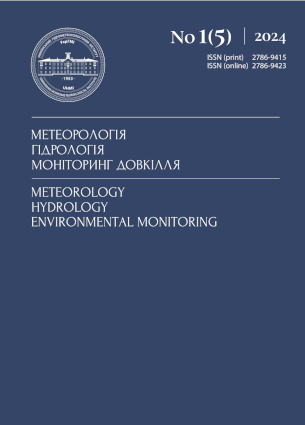Dynamical conditions of the spatial extremes formation in ozone layer over the territory of Ukraine
Ukrainian Hydrometeorological Institute of the State Emergency Service of Ukraine and the National Academy of Sciences of Ukraine, Kyiv
https://orcid.org/0009-0008-4867-4430
Sofiia Krainyk
Ukrainian Hydrometeorological Institute of the State Emergency Service of Ukraine and the National Academy of Sciences of Ukraine, Kyiv
https://orcid.org/0009-0004-6299-0983
Mykhailo Savenets
Ukrainian Hydrometeorological Institute of the State Emergency Service of Ukraine and the National Academy of Sciences of Ukraine, Kyiv
https://orcid.org/0000-0001-9429-6209
Abstract
References
1. Barnes, P. W., Williamson, C. E., Lucas, R. M., Robinson, S. A., Madronich, S., Paul, N. D., Bornman, J. F., Bais, A. F., Sulzberger, B., Wilson, S. R., Andrady, A. L., McKenzie, R. L., Neale, P. J., Austin, A. T., Bernhard, G. H., Solomon, K. R., Neale, R. E., Young, P. J., Norval, M., Rhodes, L. E., Hylander, S., Rose, K. C., Longstreth, J., Aucamp, P. J., Ballare, C. L., Cory, R. M., Flint, S. D., de Gruijl, F. R., Hader, D.-P., Heikkila, A. M., Jansen, M. A. K., Pandey, K. K., Robson, T. M., Sinclair, C. A., Wangberg, S., Worrest, R. C., Yazar, S., Young, A. R., & Zepp, R. G. (2019). Ozone depletion, ultraviolet radiation, climate change and prospects for a sustainable future. Nature Sustainability, 2, 569-579, https://doi.org/10.1038/s41893-019-0314-2.
2. Dütsch H.U. (1968). The photochemistry of stratospheric ozone. Quarterly Journal of Royal Meteorological Society, 94 (402), 483-497. https://doi.org/10.1002/qj.49709440205
3. Dvoretska, I. V. (2012). The features of total ozone dynamics during the modern period. Naukovi pratsi UkrNDGMI, 262, 257-271.
4. Dvoretska, I.V., Savenets, M.V., & Umanets, A.P. (2021). Updated total ozone climate normals over the territory of Ukraine. Ukrainian Hydrometeorological Journal, 28, 5-15. https://doi.org/10.31481/uhmj.28.2021.01
5. Grytsai, A.V. & Milinevsky, G. P. (2018). Total ozone content over KYIV-GOLOSEYEV station by ground-based and satellite measurements in 2010–2015. Space Science and Technology, 24(3), 40-54. https://doi.org/10.15407/knit2018.03.040
6. Harzer, F., Garny, H., Ploeger, F., Bönisch, H., Hoor, P., & Birner, T. (2023). On the pattern of interannual polar vortex–ozone co-variability during northern hemispheric winter. Atmospheric Chemistry and Physics, 23, 10661–10675. https://doi.org/10.5194/acp-23-10661-2023
7. Hersbach, H., Bell, B., Berrisford, P., Biavati, G., Horányi, A., Muñoz Sabater, J., Nicolas, J., Peubey, C., Radu, R., Rozum, I., Schepers, D., Simmons, A., Soci, C., Dee, D., Thépaut, J-N. (2023). ERA5 hourly data on pressure levels from 1940 to present. Copernicus Climate Change Service (C3S) Climate Data Store (CDS). https://doi.org/10.24381/cds.bd0915c6 (Accessed on 20.09.2024)
8. Hong, H.-J., & Reichler, T. (2021). Local and remote response of ozone to Arctic stratospheric circulation extremes. Atmospheric Chemistry and Physics, 21, 1159–1171. https://doi.org/10.5194/acp-21-1159-2021
9. Hu, D., Shi, S., & Wang Z. (2023). Link between Arctic ozone and the stratospheric polar vortex. Atmospheric and Oceanic Science Letters, 16(1), 100293. https://doi.org/10.1016/j.aosl.2022.100293
10. Hufnagl, L., Eichinger, R., Garny, H., Birner, T., Kuchař, A., Jöckel, P., & Graf, P. (2023). Stratospheric Ozone Changes Damp the CO2-Induced Acceleration of the Brewer–Dobson Circulation. Journal of Climate, 36, 3305–3320. https://doi.org/10.1175/JCLI-D-22-0512.1
11. Karadan, M., Raju, P., & Devara, P. (2022). An Overview of Stratospheric Ozone and Climate Effects. Earth and Planetary Science, 1(2), 19–34. https://doi.org/10.36956/eps.v1i2.782
12. Li, Y., Xia Y., Xie, F., & Yan Y. (2024). Influence of stratosphere-troposphere exchange on long-term trends of surface ozone in CMIP6. Atmospheric Research, 297, 107086. https://doi.org/10.1016/j.atmosres.2023.107086
13. Liu, M., & Hu, D. (2021). Different Relationships between Arctic Oscillation and Ozone in the Stratosphere over the Arctic in January and February. Atmosphere, 12, 129. https://doi.org/10.3390/atmos12020129
14. Mann, P.S. (2010). Introductory Statistics, Seventh Edition. John Wiley & Sons.
15. Mogylchak, V. Y., & Milinevsky, G. P. (2017). Variations of total ozone in the atmosphere over the territory of Ukraine. Space Science and Technology, 23(2), 41-47. https://doi.org/10.15407/knit2017.02.041
16. Rolf, M. (2009). A brief history of stratospheric ozone research. Meteorologische Zeitschrift, 18(1), 3-24. https://doi.org/10.1127/0941-2948/2009/353
17. Salby, M.L. (2008). Involvement of the Brewer–Dobson circulation in changes of stratospheric temperature and ozone. Dynamics of Atmospheres and Oceans, 44(3-4), 143-164. https://doi.org/10.1016/j.dynatmoce.2006.11.002
18. Savenets, M. V., Dvoretska, I. V., Umanets, A. P., & Grechana, N. V. (2020). Ozone layer state and level of ultraviolet irradiance over the territory of Ukraine in 2019. Ukrainian Hydrometeorological Journal, 25, 53-62. https://doi.org/10.31481/uhmj.25.2020.05
19. Shangguan, M., Wang, W., & Jin, S. (2019). Variability of temperature and ozone in the upper troposphere and lower stratosphere from multi-satellite observations and reanalysis data. Atmospheric Chemistry and Physics, 19, 6659–6679. https://doi.org/10.5194/acp-19-6659-2019
20. Shi, Y., Evtushevsky, O., Milinevsky, G., Klekociuk, A., Han, W., Ivaniha, O., Andrienko, Y., Shulga, V., & Zhang, C. (2022). Zonal Asymmetry of the Stratopause in the 2019/2020 Arctic Winter. Remote Sensing, 14, 1496. https://doi.org/10.3390/rs14061496
21. Shin, D., Song, S., Ryoo, S.-B., & Lee, S.-S. (2020). Variations in Ozone Concentration over the Mid-Latitude Region Revealed by Ozonesonde Observations in Pohang, South Korea. Atmosphere, 11, 746. https://doi.org/10.3390/atmos11070746
22. Staehelin, J., Mäder, J., Weiss, A. K., & Appenzeller, C. (2002). Long-term ozone trends in Northern mid-latitudes with special emphasis on the contribution of changes in dynamics. Physics and Chemistry of the Earth, Parts A/B/C, 27 (6–8), 461-469. https://doi.org/10.1016/S1474-7065(02)00027-X
23. Veenus. V., Shankar Das, S., & David L.M. (2023). Ozone Changes Due To Sudden Stratospheric Warming-Induced Variations in the Intensity of Brewer-Dobson Circulation: A Composite Analysis Using Observations and Chemical-Transport Model. Geophysical Research Letters, 50 (13), e2023GL103353. https://doi.org/10.1029/2023GL103353
24. Weber, M., Dikty, S., Burrows, J. P., Garny, H., Dameris, M., Kubin, A., Abalichin, J., & Langematz, U. (2011). The Brewer-Dobson circulation and total ozone from seasonal to decadal time scales. Atmospheric Chemistry and Physics, 11, 11221–11235, https://doi.org/10.5194/acp-11-11221-2011
25. Yu, Y., Wu, Y., Zhang, J., Cui, Z., Shi, C., Rao, J., Guo, D., & Xia X. (2024). Connections between low- and high- frequency variabilities of stratospheric northern annular mode and Arctic ozone depletion. Environmental Research Letters, 19, 044040. https://doi.org/10.1088/1748-9326/ad2c24
26. Zhang, C., Grytsai, A., Evtushevsky, O., Milinevsky, G., Andrienko, Y., Shulga, V., Klekociuk, A., Rapoport, Y, & Han, W. (2024). Study on the Rossby Waves Parameters in Total Ozone Over the Arctic in 2000–2021. Research Advances in Environment, Geography and Earth Science, 3, 72–92. https://doi.org/10.9734/bpi/raeges/v3/7572B

